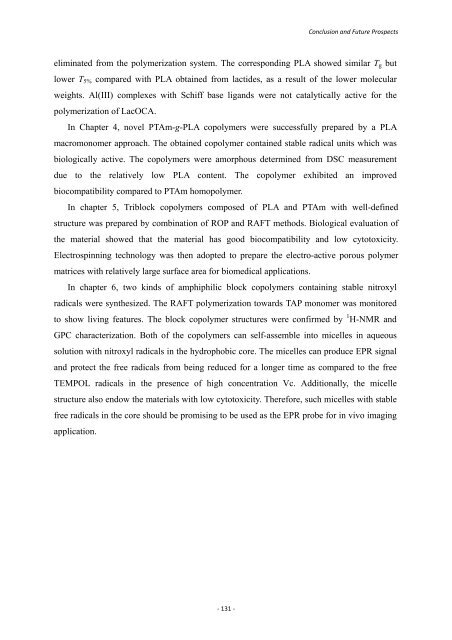Catalytic Synthesis and Characterization of Biodegradable ...
Catalytic Synthesis and Characterization of Biodegradable ...
Catalytic Synthesis and Characterization of Biodegradable ...
You also want an ePaper? Increase the reach of your titles
YUMPU automatically turns print PDFs into web optimized ePapers that Google loves.
‐ 131 ‐<br />
Conclusion <strong>and</strong> Future Prospects<br />
eliminated from the polymerization system. The corresponding PLA showed similar Tg but<br />
lower T5% compared with PLA obtained from lactides, as a result <strong>of</strong> the lower molecular<br />
weights. Al(III) complexes with Schiff base lig<strong>and</strong>s were not catalytically active for the<br />
polymerization <strong>of</strong> LacOCA.<br />
In Chapter 4, novel PTAm-g-PLA copolymers were successfully prepared by a PLA<br />
macromonomer approach. The obtained copolymer contained stable radical units which was<br />
biologically active. The copolymers were amorphous determined from DSC measurement<br />
due to the relatively low PLA content. The copolymer exhibited an improved<br />
biocompatibility compared to PTAm homopolymer.<br />
In chapter 5, Triblock copolymers composed <strong>of</strong> PLA <strong>and</strong> PTAm with well-defined<br />
structure was prepared by combination <strong>of</strong> ROP <strong>and</strong> RAFT methods. Biological evaluation <strong>of</strong><br />
the material showed that the material has good biocompatibility <strong>and</strong> low cytotoxicity.<br />
Electrospinning technology was then adopted to prepare the electro-active porous polymer<br />
matrices with relatively large surface area for biomedical applications.<br />
In chapter 6, two kinds <strong>of</strong> amphiphilic block copolymers containing stable nitroxyl<br />
radicals were synthesized. The RAFT polymerization towards TAP monomer was monitored<br />
to show living features. The block copolymer structures were confirmed by 1 H-NMR <strong>and</strong><br />
GPC characterization. Both <strong>of</strong> the copolymers can self-assemble into micelles in aqueous<br />
solution with nitroxyl radicals in the hydrophobic core. The micelles can produce EPR signal<br />
<strong>and</strong> protect the free radicals from being reduced for a longer time as compared to the free<br />
TEMPOL radicals in the presence <strong>of</strong> high concentration Vc. Additionally, the micelle<br />
structure also endow the materials with low cytotoxicity. Therefore, such micelles with stable<br />
free radicals in the core should be promising to be used as the EPR probe for in vivo imaging<br />
application.

















